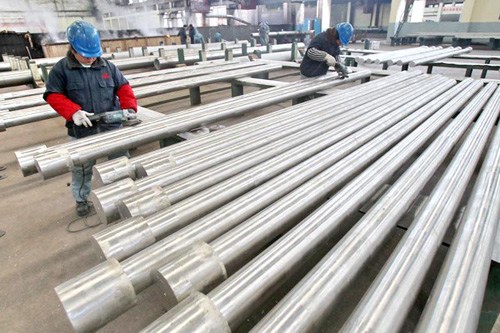
Industry experts say 83 percent of firms losing money as prices continue to fall
China's steel prices fell to 3,684 yuan ($585) a metric ton on Wednesday, their lowest level since late 2009, and senior officials said the fourth quarter will be even more difficult for the industry.
Steel prices are now dropping at a daily rate of more than 15 yuan a ton, said Zhu Xian, a senior analyst at the industrial consultancy Mysteel.
He predicted that the price will have fallen by another 50 yuan a ton by the end of Friday.
"Steel prices have now come back to the same level they were at in October 2009," added Wang Guoqing, deputy director of Lange Steel Information Research Center, an industrial consultancy based in Beijing.
China's steel inventories were 14.87 million tons on Aug 24, 380,900 tons less than the previous week, which represented the fastest drop in several weeks, according to Lange's market monitoring system.
However, crude steel output is still increasing.
According to the China Iron and Steel Association, its member companies had a daily output of 1.63 million tons in early August, an increase of 1.24 percent compared with late July.
The real estate industry, a key factor in China's steel demand, experienced slower investment growth in the first half of 2012.
China's investment in real estate totaled 3.68 trillion yuan in the first seven months, a 15.4 percent increase year-on-year, but 1.2 points down compared to the first six months of the year.
During the first seven months of last year, the investment growth rate in the real estate industry had been 33.6 percent.
"Downstream demand for steel products is still uncertain and is unlikely to rebound in the short term," said Ji Xiaoyun, an analyst at Lange.
"The central government's controls on the real estate industry are still tight, which indicates it will not contribute much more than it currently does to steel demand. But it is worth noting, August is the traditional weak season for steel prices."
She said major domestic steel companies have all cut their product prices by an average of 10 yuan to 30 yuan for September to adjust to market conditions.
Gao Cheng, sales manager at Tangshan Liangang Steel Rolling Co Ltd in Hebei province, among China's largest steel companies, told China Daily: "Many steel mills have stopped production for maintenance in Tangshan."
He said his company still has a daily output of 25 million tons, which he considers a good performance.
Xu Xiangchun, an analyst at Mysteel, said that only 60 percent of producers of construction steel in the city are currently producing.
"At the beginning of this month, the figure was 66 percent," he added.
To boost economic growth, the Chinese government has said it will accelerate the speed at which it approves infrastructure construction projects.
However, Xu said the measure will take time to take effect, maybe by the end of this year, or even the beginning of 2013.
Wang Xiaoqi, vice-chairman of the steel industry association, said during a recent key industrial conference that steel companies have to prepare themselves for a long, difficult period into possibly the first quarter of next year, before any stimulus policies might manage to boost the economy in any significant way.
"The unit profit of each ton of steel in China has dropped quite dramatically, to only 1.68 yuan on average," he said. "The figure was 6.8 yuan during the first half of the year."
During the global financial crisis of 2008, each ton of steel was bringing profit of about 50 yuan.
Wang said that up to 83 percent of steel producers are now losing money based on a sample survey among association members.
"The rapid development of the industry, based on increasing output, has gone. For the next 10 to 15 years, the domestic steel demand will stay at a level of 600 million to 700 million tons a year," Wang said.
"The excessive steel inventories at present will influence profits in the future, which points to tough times in the coming months."
Wang added that the main reason for ongoing losses by the steel industry was shrinking demand, while the deeper reason lies in excessive production capacities and low industrial concentration.
At present, China has about 200 companies whose annual steel production capacity is more than 1 million tons.
While the top five producers account for less than 25 percent of the total output, which shows low industrial concentration.
By the end of the last year, China's crude steel production capacity was 850 million tons, much higher than domestic consumption which was about 680 million tons, said Chi Jingdong, deputy secretary-general of the association.
He said the biggest problem facing the steel industry is how to absorb that capacity.
"We must increase exports, and explore new overseas markets," he said.
"But as well as finding new markets, we must reduce costs, save energy, and accelerate the levels of investment in new innovation in the industry - these are the four key issues for steel companies."
In 2011, China added another 56.62 million tons of crude steel output. The indirect export volume was 68.5 million tons while the domestic consumption was 49 million tons, indicating just how important that export market will be.

Copyright ©1999-2011 Chinanews.com. All rights reserved.
Reproduction in whole or in part without permission is prohibited.